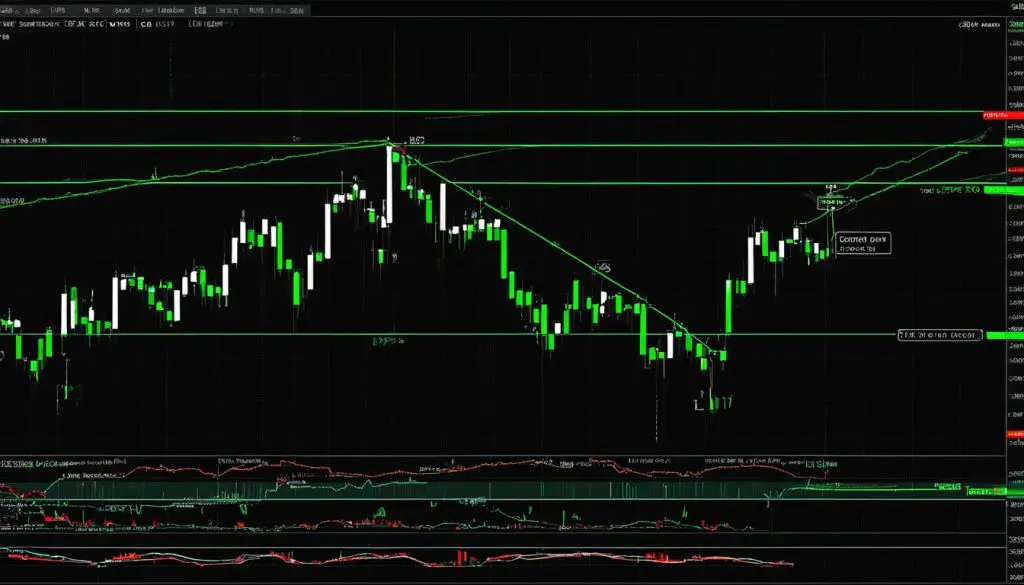Discover the world of harmonic trading patterns and enhance your wealth management strategies with the Bullish Gartley Pattern. Emerging from the work of H.M. Gartley in 1935, this well-founded technical analysis tool is grounded in the precision of Fibonacci ratios and geometric proportions. As a trader fixated on capitalizing on market reversals, the Bullish Gartley Pattern offers you a sophisticated methodology for identifying high-probability turning points in the market.
The value of a methodical approach to trading cannot be overstated, and the Bullish Gartley Pattern exemplifies a structured framework for assessing potential market reversals. By applying this pattern, you are equipped to make strategic decisions regarding entry and exit points, thus refining your trading techniques and boosting your market performance. Make the most of your trades by implementing the insights gained from the Bullish Gartley Pattern, a benchmark in the realm of technical analysis.
Understanding the Basics of the Bullish Gartley Pattern
The Gartley Pattern structure offers traders a comprehensive approach to forecast potential market reversals with increased precision. By dissecting this pattern, investors can identify critical market entry and exit points, which are essential for crafting effective trading strategies rooted in solid risk management practices.
At the heart of the pattern is the initial leg, known as X to A, which underscores a possible change in the market sentiment. Whether this shift is bullish or bearish sets the stage for subsequent market movement. The follow-up stage, A to B, should mirror key Fibonacci ratios like 38.2%, 50%, or 61.8%, serving as a litmus test for the pattern’s validity.
As the pattern progresses, the B to C leg presents an opportunity to gauge the market’s commitment to the prevailing trend. Finally, the C to D leg correlates with preceding Fibonacci ratios, culminating at point D – the anticipated reversal zone. Here, investors are poised to capitalize on the fruits of meticulous Gartley Pattern analysis.
- Initial Trend Change (X to A): Signals the potential start of a Gartley Pattern
- First Retracement (A to B): Must conform with specific Fibonacci levels
- Trend Resumption (B to C): Indicates the steadfast nature of the current trend
- Second Retracement (C to D): The final piece of the structure, leading to the suggested reversal zone
Thoroughly understanding each segment of the Gartley Pattern deepens a trader’s ability to navigate the markets with foresight and adaptability.
| Fibonacci Ratio | Relevance to Gartley Pattern | Typical Application |
|---|---|---|
| 38.2% | Serves as a shallow retracement indication, often seen in A to B | Forecasts conservative reversal zones |
| 50% | A midway pullback, balancing sentiment between bulls and bears | Suggests moderate market reversal areas |
| 61.8% | Implies a deeper correction, typical of robust retracements | Identifies aggressive potential reversal points |
Incorporating these insights into everyday trading, individuals expand their strategic toolkit, which is imperative for navigating the ebbs and flows of market dynamics.
Importance of Fibonacci Ratios in the Bullish Gartley
Incorporating Fibonacci numbers in trading, particularly within the realms of harmonic patterns like the Bullish Gartley, is not just an intellectual exercise but a strategic necessity. These sequences and ratios are more than mere numbers—they signify an underlying order and predictability in price movements. The utilization of Fibonacci retracements and extensions is central to the technical analysis tools leveraged by traders aiming to discern and forecast market trends with greater accuracy.
Origins of Fibonacci in Trading
The marriage of Fibonacci numbers with trading analysis tools dates back to the discovery that financial markets exhibit certain mathematical ratios found in nature. Traders observed that these ratios often predict price retracements with a startling degree of accuracy, thus enriching trading practices with deeper insights into market behavior. The sequential harmony of Fibonacci offers a level of precision that enhances the effectiveness of trading strategies.
Applying Fibonacci Ratios to the Gartley Pattern
When it comes to the Bullish Gartley Pattern, Fibonacci ratios offer a robust confirmation mechanism. Each touchpoint at 38.2%, 50%, or 61.8% is not just a figure but a signpost, indicating where the patterns may lead to bullish reversals. By applying these specific ratios to each pivot point in the pattern, from X to A down to C to D, traders can verify the validity and potential of the Gartley formation. This intersection of harmonic patterns and Fibonacci calculation stands tall as a testimony to predictable price movements within the sometimes chaotic financial markets.
The Relevance of Key Fibonacci Levels
Accuracy is paramount for Fibonacci retracements and extensions. The precision of these levels lends credence to their reliability as an analytic tool. In the context of the Bullish Gartley Pattern, the meticulous identification of these key levels can mean the difference between a confirmation of trend reversal and a false signal. As such, traders extensively use these ratios as a litmus test to ascertain the strength and possible success of trading ventures, seeing these Fibonacci numbers not just as guideposts but as fundamental to chart dating methodologies.
Ultimately, the harmonic convergence of the Bullish Gartley Pattern and Fibonacci levels underscores the intricacy and sophistication of financial markets. It reaffirms that disciplined, well-informed trading based on Fibonacci-assisted analysis can elevate the chances of capturing profitable trades, thus showcasing the indispensable value of these timeless mathematical ratios in the world of trading.
Identifying Bullish Gartley: Key Price Movements and Retracements
In the realm of technical trading, recognition of distinct price movements and retracement levels is pivotal for the identification of the Bullish Gartley pattern, an influential factor in trend prediction and chart pattern analysis. The efficacy of harmonic pattern identification lies in understanding the intricacies of trading wave structure, which is indispensable for traders aiming to capitalize on this pattern.
Initial Move: Understanding the ‘X to A’ Phase
Marking the inception of the harmonic pattern, the ‘X to A’ phase is where traders must lay their analytic foundation. This critical segment encapsulates the genesis of the pattern and sets the stage for upcoming price actions, signifying an impending trend.
First Retracement: Decoding the ‘A to B’
The ‘A to B’ retracement offers the first test in confirming the Bullish Gartley pattern. It encompasses a pivotal price correction against the preceding move. The depth of this leg, gauged using Fibonacci ratios, can provide a window into the market’s pulse, shaping the next chapter of this harmonic narrative.
Second Move: Analyzing ‘B to C’
The progression from ‘B to C’ resumes the prior trend direction, further engendering trust in the pattern’s development. This affirmative march verifies the information hinted at in the initial move, helping forecast the strength and validity of the pattern.
Second Retracement: The Critical ‘C to D’
The ‘C to D’ segment is where the timely anticipation of price reversal comes into play. As prices retrace, hitting specific Fibonacci levels, they approach the coveted ‘D’ point. It is here that traders are primed to employ their insight, potentially exploiting a reversal for favorable market entry or exit.
Mastering the Bullish Gartley pattern is akin to demystifying the market’s fluctuating symphony, equivocal yet structured, erratic yet rhythmic. Traders who proficiently dissect these movements can aspire to orchestrate successful trades by staying in tune with the market’s ever-evolving song.
The Significance of the Bullish Gartley in Technical Analysis
Within the realm of technical analysis, the Bullish Gartley Pattern is renowned for its systematic trading approach, providing a solid framework for identifying key market transitions. This heralded configuration is built on the premise of structured and recurrent price action confirmation, serving as an indispensable component among a plethora of technical analysis tools.
The stature of the Bullish Gartley lies in its implications; it is a testimonial to the validity of trading patterns, deftly harmonizing historical data with statistical reliability. By capitalizing on these patterns, traders can distill insightful predictions, setting the stage for potential profitability.
Recognizing the integral patterns within Gartley structures enables traders to eschew dependence on speculative guessing. Instead, it ushers in a new echelon of precision in determining viable market entry and exit junctures.
- Spotting potential reversal zones
- Validating trading decisions with historical price structures
- Constructing an analytical criteria-based blueprint for trading
This strategic pattern has made inroads in traders’ arsenals, allowing for a disciplined approach to market analysis, and underscores the seamless synergy between the Gartley Pattern and sustained trading success.
| Technical Aspect | Function in the Gartley Pattern | Benefits |
|---|---|---|
| Fibonacci Retracements | Confirm potential reversal zones | Enhanced accuracy in predictions |
| Price Structure Analysis | Outline clear trading patterns | Historically-informed trading strategies |
| Market Sentiment | Aid in understanding bull/bear strength | Improved decision-making capabilities |
In essence, by embracing the salient features of the Bullish Gartley Pattern, traders elevate their craft, evolving beyond the normative scopes of market scrutiny to adopt a refined, systematic trading framework, ripe with empirical and quantitative verification.
Trading Strategies Based on the Bullish Gartley Pattern
The Bullish Gartley Pattern offers strategic entry and exit points designed for traders to maximize profitability while managing risk. By analyzing the geometric proportions and Fibonacci ratios inherent to the pattern, traders can position themselves optimally within the market’s rhythm. The sensibility of entering a trade at the completion of the pattern’s final leg, point ‘D’, can be instrumental in harnessing the turning points in market trends. This, partnered with precise risk management methods and an understanding of target levels, fosters a cohesive strategy that marries principles of risk-reward ratio and technical acumen for price pattern trading.
Entering a Trade at Point ‘D’
At the heart of the Bullish Gartley Pattern is point ‘D’ – a pivotal indicator of trade entry that forecasts an imminent price direction change. Adherence to the Gartley pattern trade entry guidelines ensures that traders embark on new positions primed for the projected trend resurgence. With the affirmation of the pattern’s Fibonacci relationships, traders can expect a tangible framework upon which reliable trades can be constructed, reducing the reliance on speculative maneuvers.
Setting Stop-Loss Orders with Gartley
Implementing a shrewd stop-loss strategy is second to none when it comes to securing capital against adverse market movements. The meticulous placement of stop-loss orders underpins the essential doctrine of wealth preservation within the Gartley Pattern’s structure. Through setting these orders just beyond the pattern’s completion zone, traders ensure their risk exposure is minimized, which is a critical component of effective trade management.
Profit Targets and the Gartley Pattern
Defining clear profit targets is crucial for the realization and profit optimization in trading with the Gartley Pattern. The articulation of conservative targets at point B, intermediate targets at point A, and the aggressive use of Fibonacci extensions empowers traders to lock in proceeds while still participating in the market’s potential upside. The discerning application of these levels equates to an astute balance between ambition and prudence, providing a foundation for sustainable trading success.
FAQ
The Bullish Gartley Pattern is a harmonic trading pattern used in technical analysis that indicates potential market reversals. It’s based on Fibonacci ratios and geometric proportions, identifying strategic entry and exit points to capitalize on market movements.
Fibonacci Ratios are crucial in the analysis of the Bullish Gartley Pattern because they provide objective criteria for validating potential reversals. Ratios like 38.2%, 50%, and 61.8% are used to measure the strength and correctness of the pattern’s distinct price movements.
The Bullish Gartley Pattern is significant in technical analysis as it provides traders with a systematic method of spotting potential market reversals. It utilizes historical price data and objective criteria, enhancing the validity and rigor of trading decisions.
The strategy for entering a trade based on the Bullish Gartley involves initiating a position at the pattern’s completion point ‘D’, where a trend reversal is highly probable. Confirmation through Fibonacci confluences is critical before execution.






